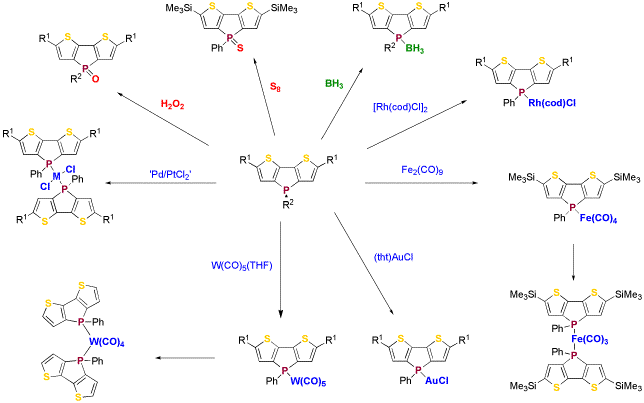
The versatile reactivity and electronic nature of phosphorus offer considerable promise for the development of new functional materials with novel properties. Exploring the use of phosphole (A) in this context is of particular interest, as materials possessing the structurally related pyrrole (B) and thiophene (C) moieties are already well-established in the field of organic electronics. These materials show significant potential for application in electronic devices such as photovoltaic cells, organic or polymer light-emitting diodes (OLEDs or PLEDs), polymeric sensors or in TFT-based flat panel displays.
One of our 'trademark' building blocks is the strongly blue fluorescent dithienophosphole system (D). This system allows for a selective tuning of the electronic properties of the materials by functionalization of the central phosphorus atom. Like almost no other element, phosphorus is particularly suited to act as a bridging element in the dithieno-system because of its nucleophilic nature. Its ability to react with a variety of reagents offers a unique variety of synthetically facile possibilities to modify the electronic properties of the dithienophosphole materials efficiently (see below). Upon these chemical modifications, the fluorescence properties of the dithienophospholes change markedly reflecting the altered electronic structure (band gap) of the materials. The photoluminescence properties of dithienophospholes are unprecedented with quantum yield efficiencies ranging between 50 to 90%. These features strongly support a potential application of the materials in organic electronics.

Functionalization of dithienophospholes towards the modification of their photophysical properties
Projects in the context of this research stream are generally centered around tuning the materials properties systems in terms of electronic structure (i.e. to access different optical absorption/emission properties) as well as processability (e.g. to generate corresponding polymeric systems, or thermally stable molecular materials).

A blue fluorescing polymer based on the dithienophosphole system
More recently we have established that the phosphorus center in the conjugated scaffold strongly emphasizes the electron acceptor properties of the materials. In a series of projects involving organophosphorus components within a nitrogen-based organic conjugated scafold we have successfully demonstrated their superior electron-acceptor features, compared to those of related native organic materials. Incorporation of phosphorus has opened the path to novel organic n-type materials and we are now systematially developing new, highly sought-after electron acceptors for a variety of applications in organic electronics, but also as photochemical probes and electrochemical labels.

Three electron-accepting building blocks
Further Reading:
[1] Y. Ren, T. Baumgartner, Dalton Trans. 2012, 41, 7792.
[2] C. Romero-Nieto, T. Baumgartner, Synlett 2013, 24, 920.
[3] T. Baumgartner, Acc. Chem. Res. 2014, 47, 1613.
[4] T. Linder, T. C. Sutherland, T. Baumgartner, Chem. Eur. J. 2010, 16, 7101.
[5] S. Durben, T. Baumgartner, Inorg. Chem. 2011, 50, 3823.
[6] S. Durben, T. Baumgartner, Angew. Chem. Int. Ed. 2011, 50, 7948.